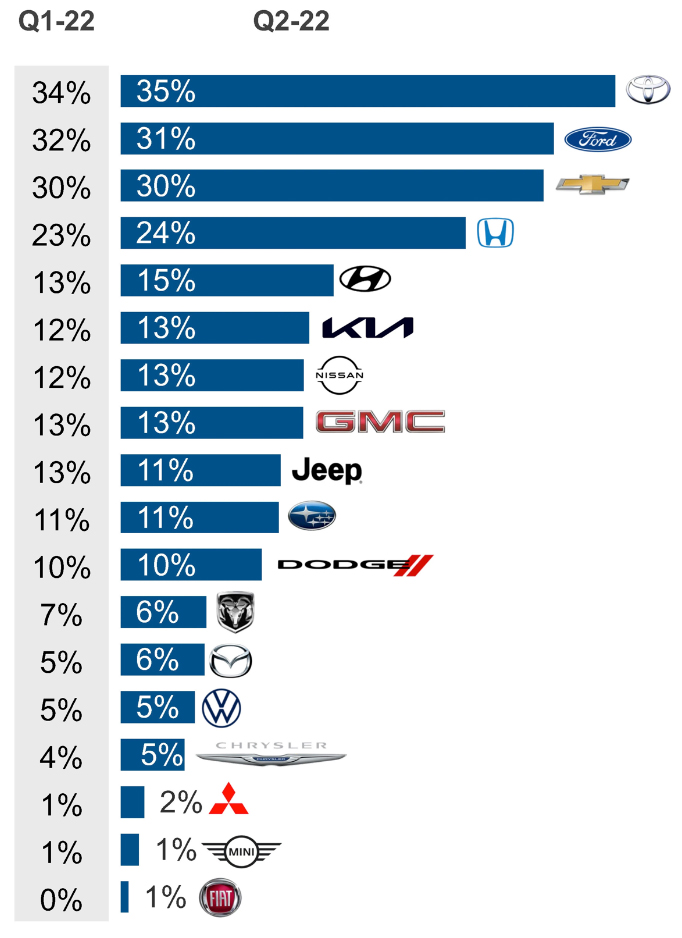The Best Car Battery Brand: Powering Your Journey with Confidence
The Best Car Battery Brand: Powering Your Journey with Confidence cars.truckstrend.com
Few components in a vehicle are as crucial yet as frequently overlooked as the car battery. It’s the silent workhorse, providing the initial surge of power to ignite your engine, stabilize your vehicle’s electrical system, and keep all your onboard electronics humming. Without a reliable battery, your vehicle is little more than a static piece of metal. But what defines "The Best Car Battery Brand"? Is it sheer power, longevity, advanced technology, or perhaps a balance of all these factors coupled with an unbeatable warranty?
The truth is, "the best" isn’t a single, universally agreed-upon brand. Instead, it’s a dynamic interplay of your vehicle’s specific needs, your driving habits, the climate you live in, and your budget. This comprehensive guide will dissect the elements that contribute to a superior car battery, explore the leading brands vying for the top spot, and equip you with the knowledge to make an informed decision, ensuring your vehicle starts reliably every time.
The Best Car Battery Brand: Powering Your Journey with Confidence
Understanding Car Batteries: More Than Just Power
Before we delve into brands, it’s essential to understand what makes a car battery tick and the key metrics that define its performance.
- Cold Cranking Amps (CCA): This is perhaps the most critical rating. CCA measures the battery’s ability to start an engine in cold temperatures. Specifically, it’s the number of amperes a 12-volt battery can deliver at 0°F (-18°C) for 30 seconds while maintaining at least 7.2 volts. Higher CCA is vital for vehicles in colder climates or those with larger engines.
- Reserve Capacity (RC): RC indicates how long a fully charged battery can power essential accessories (like headlights, wipers, and ignition) if the alternator fails. It’s measured in minutes at 80°F (27°C) while delivering 25 amps. A higher RC means your car can run longer on battery power alone, giving you more time to reach safety.
- Voltage: Standard car batteries are 12-volt, composed of six 2-volt cells.
- Amp-Hours (Ah): This measures the battery’s total energy capacity, particularly relevant for deep-cycle applications or vehicles with extensive electronic systems that draw power even when the engine is off.

Types of Car Batteries:
- Flooded Lead-Acid (SLA): The most common and traditional type. These batteries contain a liquid electrolyte (sulfuric acid and water) that requires occasional maintenance (checking water levels in some designs). They are generally the most affordable.
- Absorbed Glass Mat (AGM): A more advanced version of lead-acid, where the electrolyte is absorbed into fiberglass mats between the plates. AGM batteries are sealed, maintenance-free, spill-proof, more resistant to vibration, and can handle deeper discharges. They are ideal for modern vehicles with start-stop systems or extensive electronics.
- Gel Cell: Similar to AGM, but the electrolyte is in a gel form. Less common for starting applications, more suited for deep cycle use, and very resistant to vibration and extreme temperatures. However, they are sensitive to overcharging.
What Makes a Car Battery "The Best"? Key Considerations
When evaluating car battery brands, several factors contribute to their perceived "best" status:
- Reliability & Longevity: A truly "best" battery should offer consistent performance throughout its lifespan, typically 3-5 years, sometimes more. Brands known for durable construction and quality materials often lead here. A strong warranty (e.g., 3-year free replacement, followed by a prorated period) is a good indicator of a manufacturer’s confidence in their product.
- Performance (CCA & RC Match): The best battery for your car will meet or exceed the CCA and RC specifications recommended by your vehicle manufacturer. Over-specifying can provide a buffer, especially in harsh climates, but ensure it fits physically.
- Technology & Type: For modern vehicles equipped with advanced electronics, regenerative braking, or start-stop technology, an AGM battery is often not just recommended but required. Attempting to use a traditional flooded battery can lead to premature failure and system malfunctions.
- Brand Reputation & Reviews: Established brands with a long history often have a proven track record. Checking independent reviews and consumer feedback can provide valuable insights into real-world performance and customer service.
- Maintenance Requirements: Most modern batteries are "maintenance-free," meaning they are sealed and don’t require electrolyte level checks. This convenience adds to a battery’s appeal.
- Price vs. Value: While a higher price often correlates with better quality and performance (e.g., AGM batteries are more expensive but offer superior benefits), the "best" battery is one that provides optimal value for your specific needs and budget, balancing initial cost with lifespan and performance.
Top Contenders for "The Best Car Battery Brand"
While "best" is subjective, several brands consistently rank high in performance, reliability, and customer satisfaction. Here are some of the leading contenders:
- Optima Batteries: Renowned for their unique SpiralCell Technology, Optima batteries (RedTop for starting, YellowTop for deep-cycle/starting, BlueTop for marine/RV) are high-performance AGM batteries. They offer superior vibration resistance, faster recharging, and longer shelf life. They are often pricier but deliver exceptional performance, especially in demanding applications.
- Interstate Batteries: A household name in the U.S., Interstate has an extensive network and offers a wide range of reliable flooded lead-acid and AGM batteries for various applications. Their reputation is built on consistent quality, solid warranties, and widespread availability, making them a go-to for many mechanics and consumers.
- ACDelco: As the original equipment (OE) supplier for General Motors vehicles, ACDelco batteries are known for their reliable performance and compatibility. They offer a comprehensive line, including Advantage, Professional, and Gold series, covering both flooded and AGM options, often at competitive price points.
- DieHard (by Clarios/Advance Auto Parts): An iconic brand, DieHard has a long-standing reputation for powerful and dependable starting power. Now manufactured by Clarios (formerly Johnson Controls), they offer various series (Silver, Gold, Platinum) including AGM technology, catering to different needs and budgets, backed by a strong warranty.
- Odyssey (by EnerSys): Considered a premium, high-performance battery, Odyssey batteries utilize Thin Plate Pure Lead (TPPL) technology. They offer incredibly high CCA, rapid recharge capabilities, and exceptional deep-cycle performance. While one of the most expensive options, they are favored for heavy-duty vehicles, performance cars, and applications requiring extreme reliability.
- EverStart (Walmart Brand): Often manufactured by Clarios (the same company behind DieHard), EverStart batteries offer a strong value proposition. They are widely accessible and provide dependable performance for everyday driving at a budget-friendly price. While not "premium," they represent a solid choice for many mainstream vehicles.
- Exide: A global leader in battery technology with over 130 years of experience, Exide offers a broad portfolio of batteries for automotive, marine, and industrial applications. They are known for their innovation and quality, offering reliable flooded and AGM options.
- Varta (by Clarios): A leading battery brand in Europe, Varta batteries are known for their high quality, reliability, and innovative technologies, particularly in AGM and EFB (Enhanced Flooded Battery) for start-stop vehicles. While less common as a direct retail purchase in North America, they are often OEM in imported vehicles.
Choosing the Right Battery for Your Vehicle: A How-To Guide
Selecting the "best" battery for your car involves more than just picking a brand. Follow these steps:
- Consult Your Owner’s Manual: This is your primary resource. It will specify the exact battery group size (e.g., Group 24, 35, 65, H6, H7), minimum CCA rating, and often the recommended RC.
- Match or Exceed CCA: Never go below your vehicle’s recommended CCA. Exceeding it slightly (e.g., 10-20%) can provide a buffer, especially in cold climates, but ensure the battery still fits the tray.
- Consider Your Climate: If you live in a region with harsh winters, prioritize higher CCA ratings. Extreme heat can also degrade batteries faster, so a robust, heat-resistant design is beneficial.
- Assess Your Driving Habits:
- Short trips/Infrequent driving: Consider an AGM battery or using a battery tender to maintain charge, as short trips don’t allow the alternator to fully recharge the battery.
- Long commutes: A standard flooded battery is often sufficient.
- Vehicles with extensive electronics (GPS, heated seats, powerful audio): Look for higher RC and Amp-Hour ratings, and consider an AGM battery for better power delivery and deep-cycle tolerance.
- Check Physical Dimensions: Ensure the new battery’s dimensions (length, width, height) match your old battery or the battery tray in your vehicle. The terminal post locations (top, side, positive/negative orientation) must also match.
- Consider Technology (Flooded vs. AGM): If your car has start-stop technology, regenerative braking, or a high electrical load, an AGM battery is usually mandatory. For older, simpler vehicles, a flooded battery might be perfectly adequate and more cost-effective.
- Read Reviews and Warranty Information: Look for consistent positive feedback and a strong warranty from the manufacturer.
Maximizing Your Car Battery’s Lifespan: Tips and Maintenance
Even the "best" battery can fail prematurely without proper care.
- Keep it Clean: Regularly clean battery terminals to prevent corrosion. Use a wire brush and a mixture of baking soda and water. Ensure connections are tight.
- Avoid Deep Discharges: Letting your battery completely drain repeatedly significantly shortens its life. If your car sits for long periods, use a battery tender/maintainer.
- Drive Regularly: Short trips don’t allow the alternator to fully recharge the battery. Take longer drives periodically to ensure a full charge.
- Check Your Charging System: A faulty alternator can either undercharge (leading to a dead battery) or overcharge (damaging the battery). Have your charging system checked periodically.
- Insulate in Extreme Climates: In very hot climates, a battery heat shield can help reduce internal temperatures. In very cold climates, a battery blanket can help maintain starting power.
Challenges and Solutions
- Battery Dies Unexpectedly: Have your battery and charging system tested by a professional. If the battery is old, replace it. If new, check for parasitic drains.
- Corrosion on Terminals: Clean regularly with a baking soda solution. Apply anti-corrosion spray or felt washers.
- Slow Cranking in Cold Weather: This is a sign of a weak battery or insufficient CCA. Consider a higher CCA battery or getting your existing one tested/charged.
- Parasitic Drain: If your battery dies even when the car is off, an electrical component might be drawing power. This often requires professional diagnosis.
Practical Advice and Actionable Insights
- Don’t Skimp on Quality: While budget is a factor, investing in a reputable brand with a good warranty often saves money in the long run by preventing premature failures and tow bills.
- Professional Installation: If you’re not comfortable replacing the battery yourself, especially in modern vehicles with complex electrical systems that might require battery registration, opt for professional installation.
- Recycle Old Batteries: Always dispose of old batteries responsibly at an auto parts store or recycling center.
Table: Representative Car Battery Brand Information & Typical Pricing
| Brand | Key Features & Technology | Typical Price Range* | Warranty (Avg.) | Ideal Use Case |
|---|---|---|---|---|
| Optima | AGM SpiralCell (RedTop, YellowTop, BlueTop), High Vibration Resistance, Fast Recharge | $$$ | 36-48 months | Performance, Off-road, Heavy-duty, Marine, Deep-Cycle |
| Interstate | Wide range (Flooded, AGM), Reliable, Extensive Network | $$-$$$ | 18-36 months | General purpose, Reliable daily drivers |
| ACDelco | OEM quality (GM), Flooded & AGM, Good Value | $$-$$$ | 18-42 months | GM vehicles, General purpose |
| DieHard | Flooded & AGM (Silver, Gold, Platinum), Dependable Power | $$-$$$ | 24-48 months | General purpose, Good balance of price & performance |
| Odyssey | TPPL (Thin Plate Pure Lead) AGM, Extreme CCA & RC, Long Life | $$$$ | 48-72 months | High-performance, Commercial, Demanding applications |
| EverStart | Flooded & AGM (Value-focused), Wide Availability | $ | 12-24 months | Budget-conscious, Standard vehicle needs |
| Exide | Flooded & AGM, Long history, Global presence | $$-$$$ | 24-36 months | General purpose, European vehicle compatibility |
| Varta | AGM & EFB, High quality, OEM in European cars | $$-$$$ | 24-48 months | European vehicles, Start-Stop systems |
*Price Range Key: $ = $100-150, $$ = $150-200, $$$ = $200-300, $$$$ = $300+ (Prices are highly approximate and vary by specific model, retailer, and region.)*
Frequently Asked Questions (FAQ)
Q1: How long do car batteries typically last?
A1: On average, a car battery lasts 3 to 5 years. Factors like climate (extreme heat or cold), driving habits (short trips vs. long), and maintenance can significantly affect its lifespan.
Q2: What are CCA and RC, and why are they important?
A2: CCA (Cold Cranking Amps) measures the battery’s ability to start your engine in cold weather. RC (Reserve Capacity) indicates how long your battery can power essential accessories if your alternator fails. Both are crucial for reliable vehicle operation; higher numbers are generally better, provided they match your vehicle’s requirements.
Q3: Should I get an AGM battery for my car?
A3: If your vehicle has a start-stop system, extensive electronics, or if you live in extreme climates, an AGM battery is highly recommended, or even required. They offer better vibration resistance, deeper discharge cycles, and longer life compared to traditional flooded batteries, though they are more expensive. For older, simpler vehicles, a standard flooded battery might suffice.
Q4: Can I replace my car battery myself?
A4: Yes, but with caution. Always disconnect the negative terminal first and reconnect it last. Ensure the new battery matches the old one’s specifications and terminal orientation. For modern vehicles, battery replacement can sometimes require special tools or computer reprogramming (battery registration) to avoid electrical issues, in which case professional installation is advised.
Q5: What causes a car battery to die prematurely?
A5: Common causes include extreme temperatures (hot or cold), frequent short trips that don’t allow a full recharge, leaving lights or accessories on, a faulty alternator (over or undercharging), excessive vibrations, and parasitic drains from faulty electrical components.
Q6: Is a more expensive battery always better?
A6: Not necessarily, but there’s often a correlation between price and quality/performance. More expensive batteries often feature advanced technologies (like AGM or TPPL), offer higher CCA/RC, and come with longer warranties. The "best" battery is one that meets your vehicle’s specific needs and your driving conditions, offering optimal value for its cost and expected lifespan.
Conclusion
The quest for "The Best Car Battery Brand" ultimately leads to a personalized choice. While brands like Optima, Interstate, ACDelco, and DieHard consistently stand out for their reliability, performance, and technological advancements, the truly "best" battery is the one that perfectly aligns with your vehicle’s specifications, your driving demands, and your budget.
By understanding the key battery metrics, knowing the different types available, and considering your unique circumstances, you can confidently select a battery that provides peace of mind and ensures your journey begins smoothly, every single time. Invest wisely in your battery, and it will reliably power your adventures for years to come.




